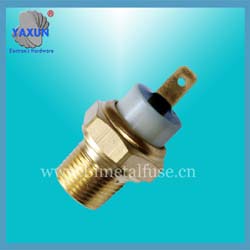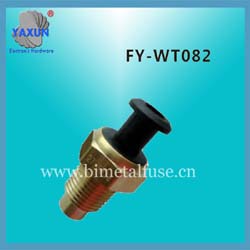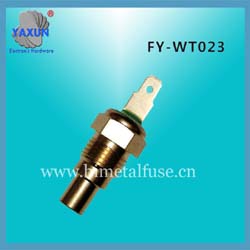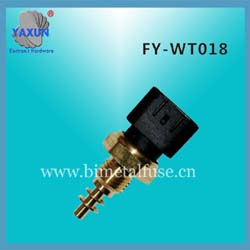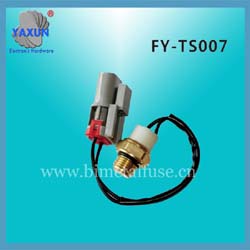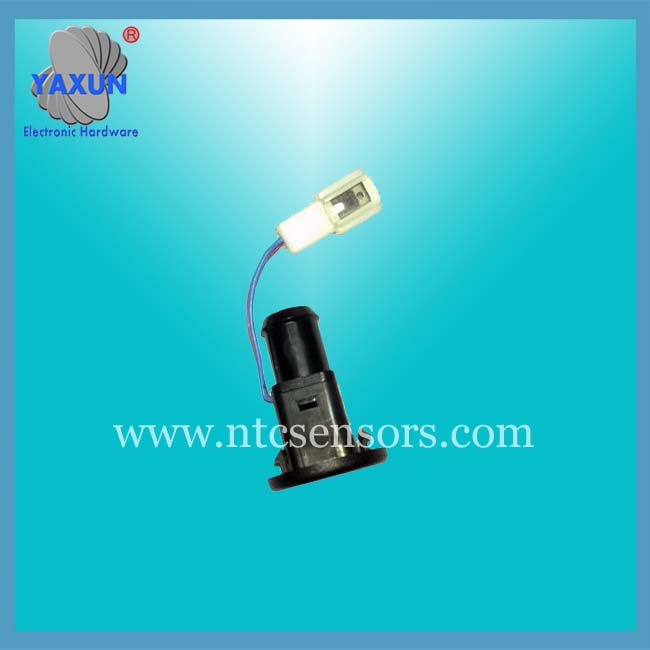Automotive electronic temperature sensor working principle and type
- PRODUCT DETAIL
Temperature is an important parameter that reflects the state of the engine's thermal load. In order to ensure that the control system can accurately control the operating parameters of the engine, the engine coolant temperature, intake air temperature and exhaust temperature must be monitored at any time in order to correct the control parameters. Calculate the mass flow rate of the intake cylinder air and perform exhaust gas purification treatment.
A Coolant Temperature Sensor (CTS) is commonly referred to as a water temperature sensor. Installed on the engine coolant outlet pipe, its function is to detect the temperature of the engine coolant and convert the temperature signal into an electrical signal for transmission to the ECu. The ECU corrects the injection time and the ignition timing based on the temperature signal of the engine, so that the engine operating conditions are optimally operated.
An Intake Air Temperature Sensor (IATS) is installed in the intake line. Its function is to detect the intake air temperature and convert the temperature signal into an electrical signal for transmission to the ECU. The intake air temperature signal is a correction signal for various control functions. If the intake air temperature sensor signal is interrupted, it will cause difficulty in hot start and increase in exhaust gas emissions.
It is well known that air weight is related to intake air temperature and atmospheric (intake) pressure. When the intake air temperature is low, the air density is high, and the weight of the same volume of gas is increased;
Conversely, as the intake air temperature increases, the weight of the same volume of gas will decrease.
In fuel injection systems using manifold pressure, vane, Kalman vortex, and core air flow sensors. Since the air flow measured by the air flow sensor is a volume flow, an intake air temperature sensor and an atmospheric pressure sensor are required.
The ECU corrects the fuel injection amount based on the intake air temperature and pressure signal of the engine, so that the engine automatically adapts to changes in external ambient temperature (cold, high temperature) and pressure (plateau, plain).
When the intake air temperature is low (the air density is high), the resistance value of the thermistor is large, the signal voltage of the sensor input ECU is high, and the ECU controls the injector to increase the fuel injection amount;
Conversely, when the intake air temperature is high (the air density is low), the thermistor resistance is small, and the signal voltage of the sensor input ECU is low, the ECU will control the injector to reduce the fuel injection amount.
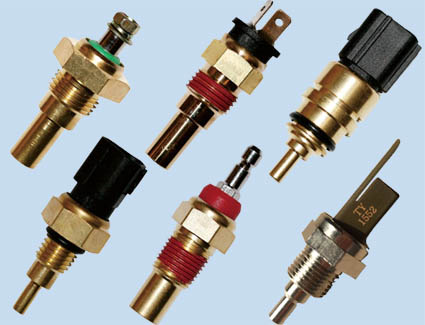
In power electronics, thermal monitoring and thermal management are very important. Temperature sensors are mainly used in battery management systems, motor control, and motors. The battery management system provides a detailed understanding of the battery's condition by monitoring the battery's voltage, current, and temperature. At the same time, a single battery unit is controlled to perform charge and discharge equalization, charging and discharging control to ensure the safe use of the battery, and at the same time, the battery life decay can be slowed down.
The measurement of voltage and current is relatively simple, but the measurement of temperature is relatively complicated. The battery design used by different customers will be different, so different batteries have different hotspot distributions and different mechanical structures. The temperature sensor must be closely combined with the hot spot of the object to be tested to accurately test the temperature of the hot spot. Therefore, the temperature sensor design of the battery management system needs to consider fast and accurate temperature measurement. Structure and installation methods need to be considered to ensure good heat transfer in the automotive environment and hotspots, while meeting the reliability and life requirements of the automotive environment.
The motor is the core component of the conversion of electrical energy into kinetic energy in new energy vehicles. Hybrid vehicles and electric cars/buses have power levels ranging from 10 kW to 200 kW. By monitoring the temperature of the motor, the motor controller can protect the entire power unit with different control strategies in different states. The internal structure of the motor is very compact, so miniaturization, high temperature requirements, resistance to harsh electromagnetic interference and high reliability are requirements for motor sensors. Yaxun Electronics has a variety of motor temperature sensors to meet the requirements of ultra-thin, high temperature, high reliability and high accuracy of hybrid systems.

A Coolant Temperature Sensor (CTS) is commonly referred to as a water temperature sensor. Installed on the engine coolant outlet pipe, its function is to detect the temperature of the engine coolant and convert the temperature signal into an electrical signal for transmission to the ECu. The ECU corrects the injection time and the ignition timing based on the temperature signal of the engine, so that the engine operating conditions are optimally operated.
An Intake Air Temperature Sensor (IATS) is installed in the intake line. Its function is to detect the intake air temperature and convert the temperature signal into an electrical signal for transmission to the ECU. The intake air temperature signal is a correction signal for various control functions. If the intake air temperature sensor signal is interrupted, it will cause difficulty in hot start and increase in exhaust gas emissions.
It is well known that air weight is related to intake air temperature and atmospheric (intake) pressure. When the intake air temperature is low, the air density is high, and the weight of the same volume of gas is increased;
Conversely, as the intake air temperature increases, the weight of the same volume of gas will decrease.
In fuel injection systems using manifold pressure, vane, Kalman vortex, and core air flow sensors. Since the air flow measured by the air flow sensor is a volume flow, an intake air temperature sensor and an atmospheric pressure sensor are required.
The ECU corrects the fuel injection amount based on the intake air temperature and pressure signal of the engine, so that the engine automatically adapts to changes in external ambient temperature (cold, high temperature) and pressure (plateau, plain).
When the intake air temperature is low (the air density is high), the resistance value of the thermistor is large, the signal voltage of the sensor input ECU is high, and the ECU controls the injector to increase the fuel injection amount;
Conversely, when the intake air temperature is high (the air density is low), the thermistor resistance is small, and the signal voltage of the sensor input ECU is low, the ECU will control the injector to reduce the fuel injection amount.
Existen muchos tipos de sensores de temperatura, como el tipo de termistor, el tipo de termistor de metal, el tipo de resistencia bobinada y el tipo de transistor. El termistor se puede dividir en un termistor de tipo coeficiente de temperatura positivo (PTC); Termistor de tipo de coeficiente de temperatura negativo (NTC); Resistencia de temperatura crítica (CTR) y termistor lineal. Los termistores utilizados comúnmente son el tipo de coeficiente de temperatura negativo y el tipo de coeficiente de temperatura positivo. Los sensores de temperatura de termistor tipo NTC, como el sensor de temperatura del refrigerante (CTS), se usan comúnmente en automóviles. Sensor de temperatura del aire de admisión (IATS), Sensor de temperatura del aire de escape (EATS), Sensor de temperatura del combustible (FTS), etc.

In power electronics, thermal monitoring and thermal management are very important. Temperature sensors are mainly used in battery management systems, motor control, and motors. The battery management system provides a detailed understanding of the battery's condition by monitoring the battery's voltage, current, and temperature. At the same time, a single battery unit is controlled to perform charge and discharge equalization, charging and discharging control to ensure the safe use of the battery, and at the same time, the battery life decay can be slowed down.
The measurement of voltage and current is relatively simple, but the measurement of temperature is relatively complicated. The battery design used by different customers will be different, so different batteries have different hotspot distributions and different mechanical structures. The temperature sensor must be closely combined with the hot spot of the object to be tested to accurately test the temperature of the hot spot. Therefore, the temperature sensor design of the battery management system needs to consider fast and accurate temperature measurement. Structure and installation methods need to be considered to ensure good heat transfer in the automotive environment and hotspots, while meeting the reliability and life requirements of the automotive environment.
The motor is the core component of the conversion of electrical energy into kinetic energy in new energy vehicles. Hybrid vehicles and electric cars/buses have power levels ranging from 10 kW to 200 kW. By monitoring the temperature of the motor, the motor controller can protect the entire power unit with different control strategies in different states. The internal structure of the motor is very compact, so miniaturization, high temperature requirements, resistance to harsh electromagnetic interference and high reliability are requirements for motor sensors. Yaxun Electronics has a variety of motor temperature sensors to meet the requirements of ultra-thin, high temperature, high reliability and high accuracy of hybrid systems.

PREVIOUS:NONE
NEXT:Capacitive Oil Level Sensor
NEXT:Capacitive Oil Level Sensor

